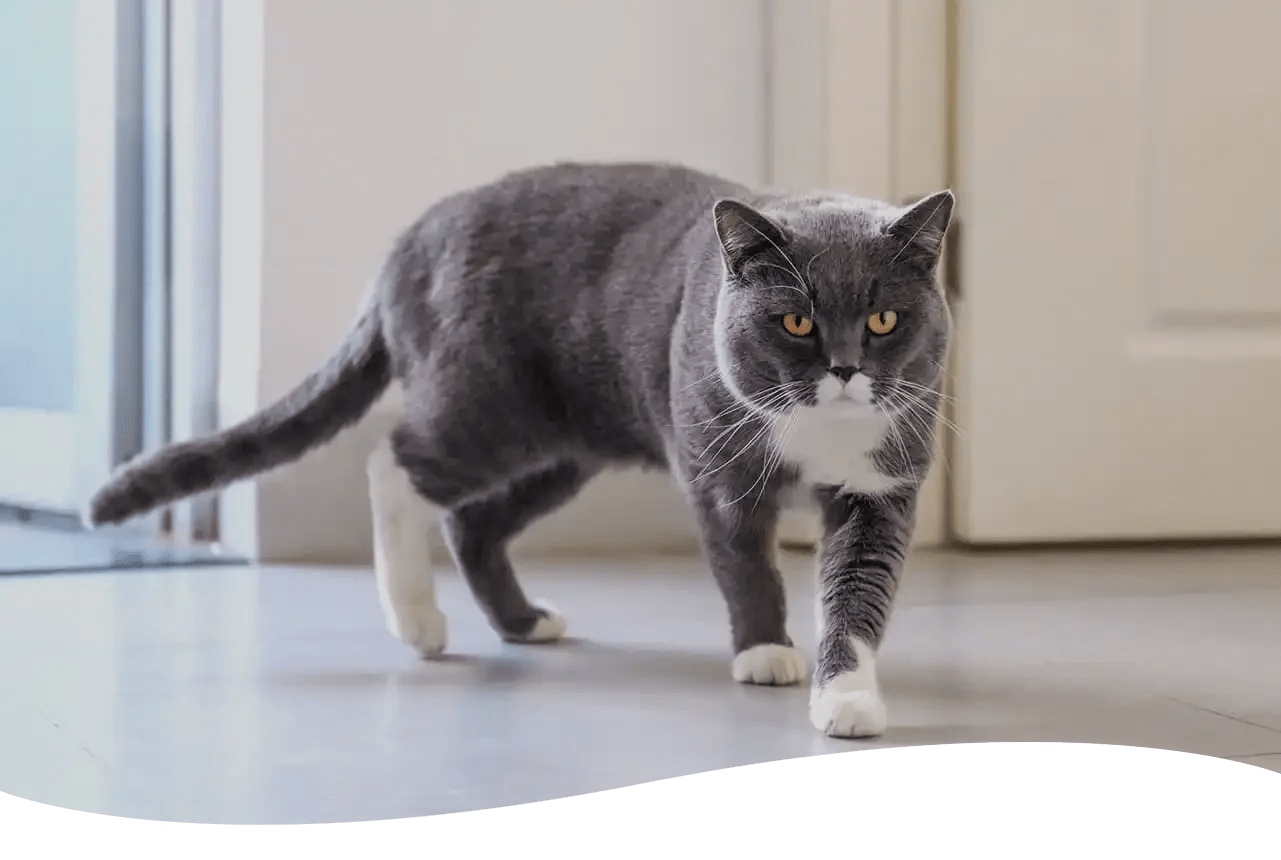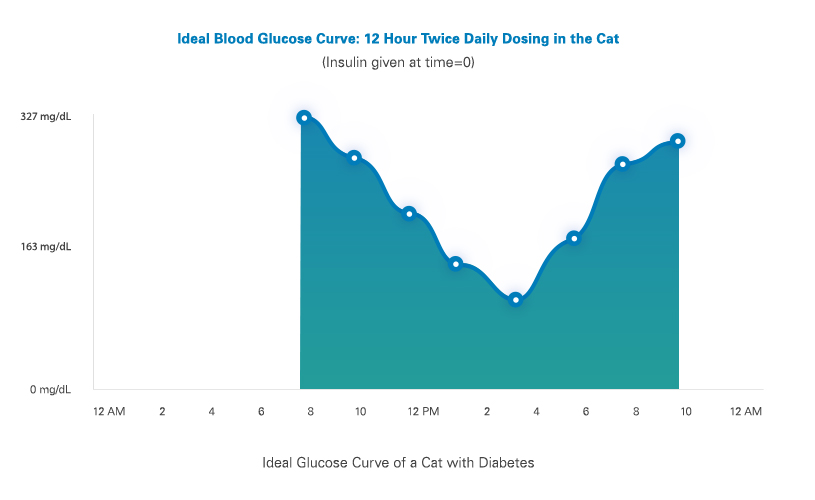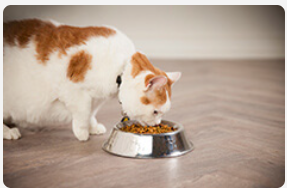

Diabetes in Cats
About Glucose Curves
Managing Feline Glucose Curves
The blood glucose curve is an ideal tool to determine the effectiveness of the insulin and identify the appropriate dose and frequency of administration. In general, maintaining blood glucose levels in a cat with diabetes between 120–300 mg/dL for the majority of the day will minimize the symptoms of diabetes and complications.
Veterinarians commonly adjust the insulin dose based on a blood glucose curve. When creating a glucose curve, remember that stress can affect the reliability of results, and the glucose curve is only one tool among others that can help diagnose and monitor diabetes mellitus. Your veterinarian will take clinical signs (or lack thereof) into account when contemplating any change in insulin therapy. The ultimate goal in regulating a cat with diabetes is to control the clinical signs adequately so your pet can enjoy a good quality of life.
How to complete a glucose curve
The procedure is as follows: shortly after your cat has been given its first meal (preferably at home), the first blood sample is taken just before the morning insulin is given. Blood samples are then collected every 2 hours throughout the day, for 12 hours if possible. This data is then plotted on a graph to generate a curve. Veterinarians will use the blood glucose curve to determine if any adjustments need to be made to the insulin dosage and feeding regimens.
How to interpret a glucose curve
The aim of treatment is to alleviate clinical signs of diabetes. To achieve this goal, veterinarians aim to keep blood glucose concentrations below the renal threshold and avoid hypoglycemia. They do this by maintaining blood glucose concentrations roughly between 120 to 300 mg/dL in cats for the majority of the day.3
The duration of insulin action is measured from the time of Vetsulin® (porcine insulin zinc suspension) injection, followed by a fall in blood glucose concentration, to the time that blood glucose exceeds the renal threshold concentration of 200 to 280 mg/dL in cats. Because stress can falsely increase the blood glucose values in cats, sometimes other blood tests are utilized to help manage the diabetic cat.
Measuring blood glucose
Two different options:
Blood samples can be taken to measure blood glucose or blood insulin concentrations. Two methods of taking blood samples to produce glucose curves include:
- Collection by your veterinarian of a venous blood sample from a peripheral vein. Plasma glucose concentrations are measured in a laboratory or by an in-clinic analyzer.
- At home, or in clinic collection of a drop of capillary blood from the pinna, analyzed using a handheld glucometer.
- Glucometers should be calibrated specifically for dogs and cats because of the difference in the ratios of glucose in plasma and red blood cells from humans.
- Readings may vary as much as 15% from samples submitted to the laboratory.
- Handheld meters are reasonably accurate. If a reading seems unusual or does not match the clinical signs, a second reading should be taken or another method used to confirm the blood glucose measurement.
Management goals
Treatment is successful when the clinical signs of diabetes mellitus improve without inducing hypoglycemia.
Routine rechecks
After your cat stabilizes successfully, your veterinarian may perform routine rechecks every 2 to 4 months. Careful monitoring and control will help to limit long-term complications.
Blood glucose concentrations
The aim of therapy is to produce a blood glucose curve that approaches the average range and avoids potentially fatal hypoglycemia. A stable cat with diabetes exhibits a blood glucose range of around 120 to 300 mg/dL for most of a 24-hour period.
Ideal blood glucose curve
The graph below demonstrates an ideal blood glucose curve for a cat receiving Vetsulin® twice daily. Not all blood glucose curves will be ideal at first.

Tracking Results

If you feel your pet is at risk for developing diabetes, consider having your pet tested during a regular veterinary examination at least once a year.
Tracking Tools & Resources
- Pet Diabetes Tracker app
Review and keep important information to manage care. - Blood Glucose Curve Tool
Easily record blood glucose readings to generate a blood glucose curve. - Helpful Downloads
Additional resources to understand and manage canine diabetes.
Further Reading


Talk to Your Vet Today
Find a veterinarian to learn more about pet diabetes, and how cats and dogs can lead a happy, healthy life with proper management.
3. Feldman EC, Nelson RW. Canine and Feline Endocrinology and Reproduction. 3rd ed. St. Louis, MO: Saunders; 2004:486–538.
IMPORTANT SAFETY INFORMATION:
VETSULIN® and VETPEN® are for use in animals only. Dogs and cats known to have an allergy to pork or pork products should not be treated with VETSULIN®. VETSULIN® is contraindicated during periods of hypoglycemia. Animals with severe ketoacidosis, anorexia, lethargy, and/or vomiting should be stabilized with short-acting insulin and appropriate supportive therapy before use. As with all insulin products, careful patient monitoring for hypoglycemia and hyperglycemia is essential. Overdosage can result in profound hypoglycemia and death. Progestogen and glucocorticoid use should be avoided. The safety and effectiveness of VETSULIN® in puppies, kittens, breeding, pregnant, and lactating dogs and cats has not been evaluated. Keep out of reach of children. Avoid contact with eyes. In case of contact, immediately flush eyes with copious amounts of water for at least 15 minutes. Accidental injection may cause clinical hypoglycemia. In case of accidental injection, seek medical attention immediately. Exposure to the product may induce a local or systemic allergic reaction in sensitized individuals. For complete safety information, refer to the product label.





